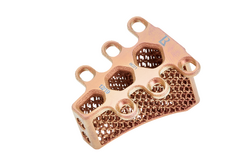TTA Rapid Cage 12/19, Titanium
Supplied By: Veterinary Instrumentation (TTAR1219)
SKU
078863
Unit of
Measure
Pack
Type Each
Case
Qty 1
Product Description
The manufacture of TTA Rapid cages has only been made possible with advances in materials and manufacturing technology. The cages are made by an additive manufacturing (AM) 3D printing process known as selective laser sintering (SLS). The process is interesting to watch. Although other materials can be used in the process, TTA Rapid cages start life as a very fine, commercially pure titanium powder. A very thin layer of titanium powder is deposited on the working bed of the SLS machine and a modified print head carrying a high intensity laser is used to selectively melt the powder to bond (sinter) regions together. As further layers of powder are applied and the laser sintering process repeated, a solid three dimensional structure begins to form within the ‘sand-pit’ of metal powder. Electron beam melting (EBM) is a similar procedure that uses an electron beam instead of a laser. Once the full structure has been created, the cages are separated from the powder and various chemical and other finishing processes are performed to leave the cages in their final, implantable state. Through this process, shapes can be created that would either be impossible to produce using more conventional technologies or cost prohibitive. In the case of TTA Rapid, a very porous honeycomb titanium lattice with a modulus similar to that of cancellous bone is generated permitting very rapid bony ingrowth to occur. Titanium is also very biocompatible, MRI compatible and typically needs to be inoculated with 10 times as many infectious units for an implant associated infection to develop when compared to stainless steel. The lattice found in the TTA Rapid cages is bound on 4 sides by an anatomically shaped, rigid shell of the same material with one side carrying lugs with screw holes in them. With the lattice, cage and screw lugs being one piece, the cages are very stable in situ. The constructs are so stable that auxiliary implants such as plates, wires, forks and staples are rarely indicated. This has a number of benefits: Reduced morbidity and biological cost that may be associated with the dissection and placement of additional implants. Reduced potential for cold conduction with superficially sited metallic implants. Fewer additional holes created in the tibial diaphysis which may contribute to crack propagation and failure of the tibial shaft. Metals of different electro-potentials are avoided in the same construct. Theoretically this reduces the potential for galvanic corrosion to occur (all components are titanium). Simplified inventory management. Potential time savings in the placement of implants.
